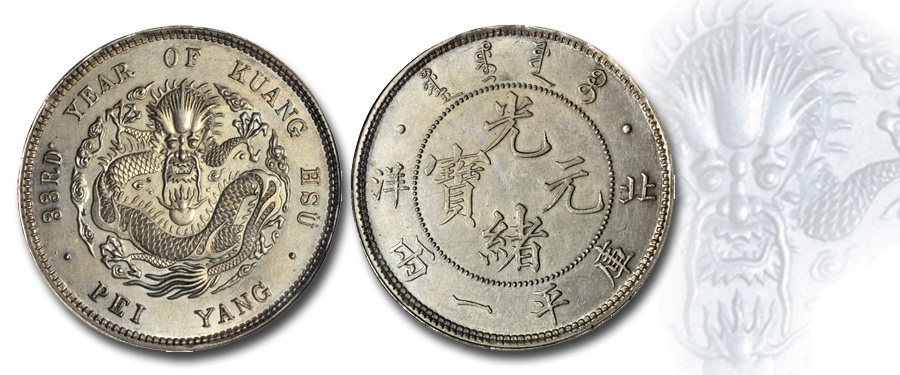
For our Hong Kong Showcase Auction highlight we feature a coin that is a classic Chinese numismatic rarity. This coin represents one of a few attempts made by the Chinese Imperial government to institute a standard coinage system based on the Tael, while simultaneously circulating with the coinage system based on the foreign denomination of dollars (7 Mace 2 Candareens) and cents. Ultimately, the Tael coinage system never caught on, partially due to the fact that Emperor Kuang Hsu died in 1908, very shortly after the official Imperial Decree was issued. This piece was minted at the Central Mint at Tientsin (Tianjin) in Chihli province in northeastern China, a region that contains the Eastern end of the Great Wall. This coinage was met with mixed approval and never gained wide acceptance. Shortly after the death of the emperor the project was aborted and attempts were made to produce a unified coinage. Allegedly only about 7,000 Pei Yang Taels were struck; however, most never entered circulation and the majority of the mintage was recalled and melted. This has significantly reduced the population of these coins and greatly enhanced the rarity of the pieces that remain.
The archetypal symbol for China, the eastern serpentine dragon, constitutes the majority of the obverse design. The dragon displays a fearsome visage, its great scaly form winding and twisting in flight. Its four limbs, tipped with fierce claws, appear equidistant from each other in a square pattern. Wisps of clouds surround the dragon, providing visual markers of its presence in the sky. The dragon’s tail ends in eight sharp prongs, with a ridge of spikes along its back culminating in a veritable crown of barbs atop its head. Long whiskers drape down past its open mouth, from which an ornate flaming pearl issues forth. The flaming pearl contains seven flames and three dots arranged in a straight line. Around the motif of the dragon, the English legend: “33rd Year of Kuang Hsu” (1907) appears above, with “Pei Yang” (mint location) appearing below. The upper and lower legends are separated by a small rosace.
The reverse design contains a Chinese and Manchu legend, within a pearled ring the large center inscription states: “Valuable Coin (of the) Kuang Hsu (regime).” The upper Manchu legend is preceded and followed by a single dot. Two symbols on either side of the outer ring denote the location of Pei Yang. The lower inscription states the weight and denomination of “K’uping 1 Tael." This stunning coin is a major highlight of the auction and is certainly on course to attract frenzied bidding once it reaches the auction podium. Light even iridescent toning with blue, yellow and golden hues crosses the entire surface, with subdued luster beneath. There are no detracting surface marks or evidence of contact, which is all the more impressive given the coin’s size and expansive open fields. This beautiful coin, one of the top rarities of all provincial issues was used as a plate example in "Top Chinese Coins" by Chou, Guth and Smith. This example is tied with one other piece in this grade for the finest certified.
Look for this and other Asian and world numismatic rarities in our upcoming April Hong Kong Showcase Auction. Preview this impressive coin along with the rest of our auction this March at the Stack’s Bowers and Ponterio office located in Irvine, California. For details please refer to the Events Calendar link at www.StacksBowers.com. To schedule an appointment, please call 800.458.4646. While our Stack’s Bowers Galleries April Hong Kong Showcase Auction is no longer open for consignments, we are currently taking consignments of ancient and world coins for our August 2015 ANA World’s Fair of Money Showcase Auction and Asian coins and currency for our August 2015 Hong Kong Showcase Auction. If you are interested in consigning your coins and paper currency (whether a whole collection or a single rarity) be sure to contact one of our consignment directors.





